Annals
of the M.B.C. - vol. 1° - n° 1 - September 1987
EPIDEMIOLOGY AND PREVENTION OF BURNS IN
CHILDREN
Barisoni D., Bortolani k Marchi A.
Divisione di Chirurgia plastica e centro Ustioni - USL 25 Regione Veneto - Verona
SUMMARY.
Epidemiological data concerning 708 burned children (age 0- 11), admitted to the Bum Unit
in Verona during the years 1976-1987 are presented. The efficacy of a prevention programme
in 1981/83 in primary and nursery schools is presented and discussed.
Introduction
The majority of bums are domestic both in children and in adults (1, 2, 3, 4, 5)
Children, in fact, still have the highest incidence of thermal injury, in domestic
premises. The predominant causes are hot liquids; flames, flash, electric and contact were
observed as well, but they were less common (4).
Epidemiological data and aetiological mechanisms are very important for a bum prevention
programme. Our experience is based on the distribution, in all the nursery and the primary
schools of the Province of Verona, Vicenza e Belluno, of a folder showing the predominant
causes of domestic burns, and explaining how to prevent thermal injuries and how to treat
them immediately after.
The aim of this report is to investigate the effect of the prevention programme against
bum domestic injuries in children through the years and to evaluate first aid measures at
home.
Materials and Methods
Between 1976 and 1987, we treated 708 burned patients, admitted to the Burns Unit in
Verona, with bums occurring in domestic premises. The ages of the patients ranged from 0
to 11 years. Besides the number, we considered the age, the
causes of the injury and the B.A.B.
Children less than 2 years of age constituted 45) 600 per cent. (Fig. 1). Hot liquids were
the most important causes of thermic lesions, representing 73.6% of all bums in children.
Flame represented 16.6%, flash 2.7%, elec tric 1.1, contact 0.9% and chemical 0.3%. The
causes were not reported in 4.8% of all the cases (Fig. 2). The extent of bums as a
percentage of the body surface area was up to 10% in 508 patients, and ranged from 10% to
20% in 136, from 20% to 40% in 53 with 2 deaths, from 40% to 60% in 5 with 1 death and in
6 patients burns were larger than 60% with 3 deaths. (Fig. 3).
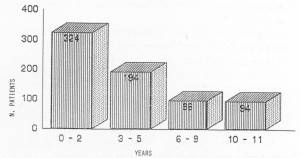 |
Figure
1 - Domestic bums in children: distribution according to age. |
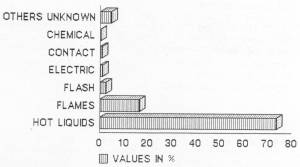 |
Figure
2 - Domestic bums in children: aetiology. |
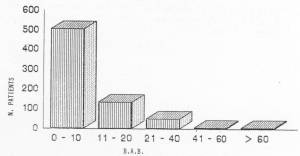 |
Figure
3 - Domestic bums in children: distribution according to B.A.B.. |
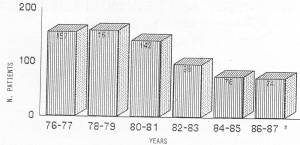 |
Figure 4 -
Domestic burns in children: number of patients admit ted * statistical expectation. |
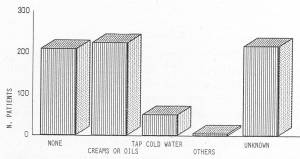 |
Figure 5 -
Domestic bums in children: irrmrediate home-care after bum. |
|
RÉSUMÉ. Les auteurs présentent les donnés
épidémiologiques de 708 enfants brûlés (age 0-11), hôspitalisés pendant la période
1976-1987
auprès le centre de brûlés de Verona.
Ils présentent aussi l'efficacité d'un programme de prevention, dans l'école primaire
et maternelle, organisé pendant la période 1981/83.
BIBLIOGRAPHY
- Elberg J.J., Schroder H.A.,
Glent-Madsen L. and Hall K.V.: "Bums: epidemiology and the effect of a prevention
programme". Burns (1987) 13, (5), 391-393.
- Gunay M.: "Burns prevention in
Europe - a report of a study tour 1982 Bums (1981-83) (9) 312-317.
- James M.H., B.A., Boshoven J., MA,
MSW: "A strategy for involving Community Groups in Burn awareness and
prevention". The bulletin and clinical review of Bum Injuries. Vol. I - Issue I -
January 1984.
- E.J. Keogh, FRCS, FRACS "Must
children continue to be scalded?" The bulletin and clinical review of Bum Injuries.
Vol. I - Issue I - January 1984.
- Keswani M.H.:"The prevention of
burning injury." Bum (1986) (8) 533-539.
- 6. Linares A.Z., Linares
H.A.:"Bums prevention programmes for children: are they effective?" Burns
(79-80) (6) 73-79.
- Young S., FRCS: "The results of a
Community Bum Prevention Program". The bulletin and clinical review of Bum Injuries.
Vol. I - Issue I - January 1984.
|




